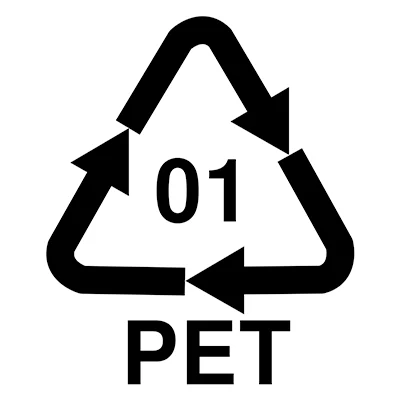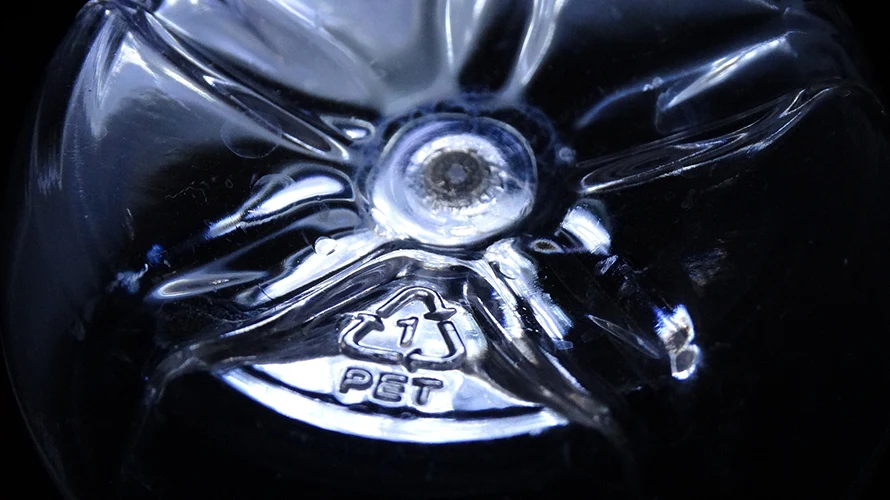A quick overview of the topics covered in this article.
Subscribe to the UKPACK newsletter to receive regular updates on the company, products, services, upcoming exhibitions and more.
In 1941, John Rex Whinfield, James Tennant Dickson, and the Calico Printers’ Association of Manchester, England, patented the use of PET. DuPont de Nemours in Delaware, United States, first trademarked the name Mylar in 1951, and it remains the most well-known name for polyester film to this day. The trademark is currently owned by DuPont Teijin Films.
What is PET Plastic?
Before we dive into the details, let’s first understand what PET plastic is.
Polyethylene terephthalate, or PET, is a clear, strong, and lightweight plastic that is commonly known as polyester. This versatile material is used in a wide range of household and industrial applications. It is one of the most prevalent plastics in use today and is also one of the most easily recycled materials.
What are The Characteristics of PET Plastic?
Some of the characteristics of PET plastic include:
- Strong and durable: PET is a strong, lightweight, and semi-rigid material that is resistant to moisture and chemicals. It can withstand high temperatures, and maintain its shape and strength even when exposed to harsh conditions.
- Clear and Transparent: PET is a clear, transparent plastic that allows for easy visibility of the contents inside, making it an ideal choice for packaging food and beverages.
- Recyclable: PET is one of the most widely recycled plastics. Many communities have programs in place to collect and recycle PET bottles and containers, and recycled PET can be used to make a variety of new products, including new bottles, fibers, and even automotive parts.
- Low moisture permeability: The low moisture permeability of PET means that it can protect the contents from moisture and gases.
- Thermoplastic: PET is a thermoplastic, which means that it can be melted and reshaped multiple times without losing its properties.
- Barrier properties: PET have good barrier properties to gases such as oxygen, carbon dioxide, and aroma.
- Food-grade: PET plastic is safe for food contact and is widely used in packaging of food and beverages.
- Low cost: The raw materials and production process are relatively cheap, making it an affordable packaging option.
What are The Disadvantages of PET Plastic?
Some of the disadvantages of PET plastic include:
- Environmental Impact: While PET is recyclable, not all of it gets recycled and it may end up in landfills, oceans and other natural environments, where it can take hundreds of years to decompose and may cause harm to wildlife and other organisms.
- Microplastics: PET bottles can break down into small particles called microplastics, which can be ingested by marine life and other animals, causing harm to their health.
- Energy-intensive production: The production of PET requires large amounts of energy, and the use of fossil fuels may contribute to environmental pollution.
- Leaching of Chemicals: PET plastic containers can leach chemicals, such as antimony, into the food or beverage they contain, especially when exposed to high temperatures or acidic conditions.
- Limited reusability: Unlike glass or metal containers, PET containers are not meant to be reused, they are designed for single use.
- Limited heat resistance: PET has a limited heat resistance, and it can lose its strength and shape when exposed to high temperatures.
- Not biodegradable: PET plastic is not biodegradable and can take hundreds of years to degrade in natural environments.
What are The Applications of PET Plastic?
There are many applications of PET plastic. Some of the most common include:
- Beverage bottles: One of the most common uses of PET is in the production of plastic bottles for beverages such as water, soda, juice, and sports drinks.
- Food packaging: PET is also used to make a variety of food packaging products, including jars, trays, and clamshell containers.
- Fibers: PET is used to make fibers for clothing, carpets, and upholstery.
- Films and sheets: PET is used to make films and sheets for packaging, labeling, and printing.
- Industrial products: PET is used to make a variety of industrial products such as strapping, conveyor belts, and gears.
- Consumer goods: PET is used to make a variety of consumer goods such as combs, razors, and toothbrushes.
- Engineering resins: PET is often combined with glass fibers to make engineering resins that are used in automotive and aerospace applications.
- Medical applications: PET is used to make a variety of medical products such as surgical instruments, and diagnostic imaging equipment like PET scanners.
Is PET Plastic Good for Cosmetic Packaging?
PET plastic is a popular choice for cosmetic packaging due to its clear, transparent and lightweight properties. And some of the specific applications of PET plastic in cosmetic packaging include:
- Bottles: PET is often used to make bottles for liquid cosmetics such as lotions, shampoos, conditioners, and shower gels.
- Jars: PET is also used to make jars for cosmetics such as creams, balms, and scrubs.
- Compacts: Compact cases for makeup such as powder, blush, and eyeshadow are often made from PET plastic.
- Lipsticks: PET is also used to make tubes for lipsticks and lip balms.
- Airless dispensers: PET is a popular choice for airless dispensers as it is lightweight and has good barrier properties to protect the contents.
Is PET Plastic Recyclable?
PET has the number “1” as its resin identification code.

Yes, PET (polyethylene terephthalate) plastic is recyclable. It is one of the most widely recycled plastics and many communities have programs in place to collect and recycle PET bottles and containers.
In the recycling process, PET is cleaned, shredded, and then melted down. The melted plastic is then extruded into pellets, which can be used to make a variety of new products, including new bottles, fibers, and even automotive parts.
The recycling rate of PET is relatively high and it can be recycled multiple times without losing its properties or quality.
However, not all PET plastic gets recycled, and it may end up in landfills, oceans, and other natural environments, where it can take hundreds of years to decompose and may cause harm to wildlife and other organisms.
How Plastic PET Bottles are Recycled into Garments
Here is the video to show you how to recycle PET bottles into garments.
The Properties of Polypropylene
| Item | Result |
|---|---|
| IUPAC Name | poly(ethylene terephthalate) |
| CAS Number | 25038-59-9 |
| ECHA InfoCard | 100.121.858 |
| UNII | 5YSH70HE6K |
| CompTox Dashboard (EPA) | DTXSID10872790 |
| Chemical Formula | (C10H8O4)n |
| Density | 1.38 g/cm3, 20 °C |
| Melting Point | > 250 °C (482 °F; 523 K) |
| Boiling Point | > 350 °C (662 °F; 623 K) |
| Young’s modulus, E | 2800–3100 MPa |
| Tensile Strength | 55–75 MPa |
| Flexural Strength | 41 MPa (6000 PSI) |
| Elastic Limit | 50–150% |
| Notch Test | 3.6 kJ/m2 |
| Water absorption (ASTM) | 0.16 |
Luxury Skincare Packaging: A Comprehensive Guide
Welcome to the captivating world of luxury skincare packaging! Whether you’re a brand owner or a beauty enthusiast, understanding the nuances of packaging can elevate your skincare game. In [...]
Creative Sunscreen Packaging Ideas: Boost Your Brand
Sunscreen is essential for skin protection, but let’s face it—its packaging can make or break a customer's first impression. In a saturated market, having creative and effective sunscreen packaging [...]
The 25 Best Hair Care Brands of 2024
Welcome to the ultimate guide to the best hair care brands of 2024! Whether you're on the hunt for products that will give you luscious locks or looking to [...]




